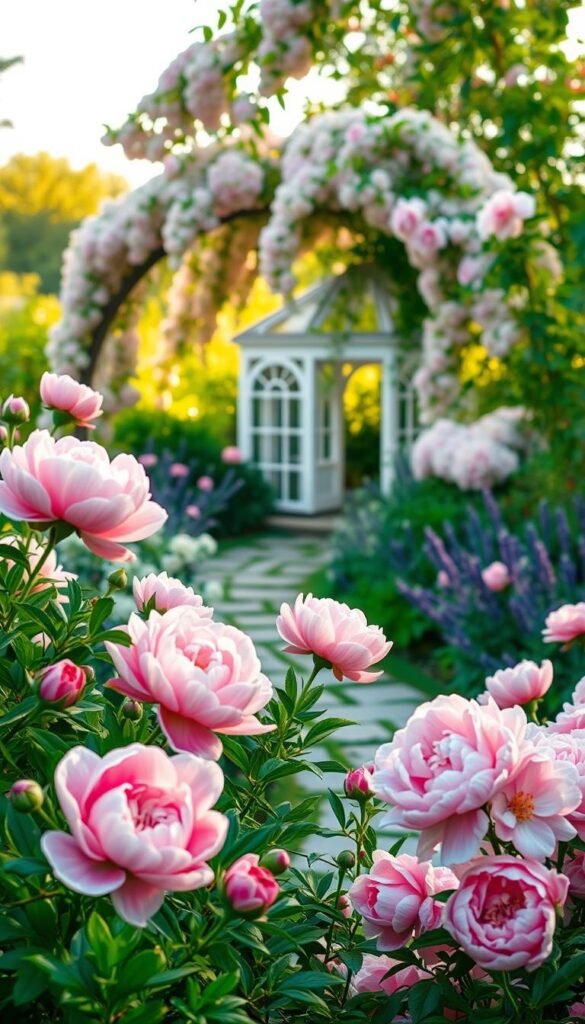Imagine stepping into a space where every petal whispers tranquility and every bloom radiates warmth. Soft-hued floral arrangements offer more than visual appeal – they create emotional connections through their gentle color spectrum. From blush tones to rosy accents, these blossoms bring versatility to any landscape or interior design.
Many gardeners favor these delicate shades for their ability to blend with various styles. Whether enhancing a cottage-style backyard or modern patio containers, the right floral selections require minimal effort while delivering maximum impact. You’ll find options thriving in both sunny spots and shaded corners, adapting effortlessly to your unique environment.
Beyond their beauty, these flowers carry deep symbolism. They’ve long represented affection, gentleness, and appreciation – perfect for spaces meant to inspire calm reflection. Their color variations allow creative expression, letting you mix textures and heights without overwhelming the senses.
This guide reveals how to cultivate lasting elegance through smart plant choices and strategic design. Discover varieties that flourish through seasons, maintenance tips for busy schedules, and ways to extend your floral theme indoors. Let’s explore how to transform ordinary areas into cohesive, inviting retreats that celebrate nature’s most romantic palette.
Introduction to Your Pink Garden Journey
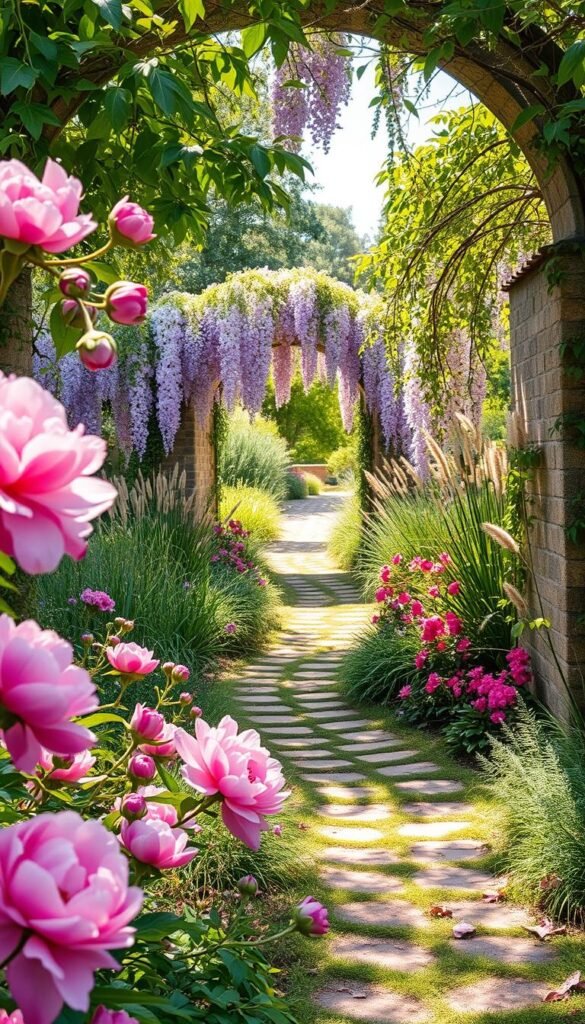
Creating a dreamy space starts with knowing your garden’s unique needs. Whether you’re designing expansive borders or small container gardens, success begins with three essentials: climate awareness, soil health, and seasonal strategy.
What You Can Expect to Learn
First, identify your USDA hardiness zone. This determines which flowers survive winter as perennials versus annuals. For example, hydrangeas thrive in zones 5-9 but need protection farther north. Soil testing kits (under $20) reveal pH levels – crucial since roses prefer 6.5 pH, while clematis grows best in neutral earth.
Setting the Stage for a Dreamy Garden
Track sunlight patterns for a week. Most pink varieties need 6+ hours of direct light, though impatiens and astilbe flourish in shade. “Layering plants by height and bloom time creates nonstop color,” notes veteran landscaper Marie Chantal. Pair early tulips with mid-summer phlox and autumn sedum for continuous charm.
Finally, sketch your space. Mix textures like velvety petunias with spiky lupines. Leave room for growth – compact dianthus stays under 12 inches, while foxgloves tower at 5 feet. With these steps, you’ll craft a living masterpiece that evolves beautifully each season.
The Beauty and Benefits of a Pink Garden Aesthetic
Surrounding yourself with gentle hues does more than please the eye—it nurtures the soul. These delicate tones create spaces that feel both inviting and restorative, blending natural charm with practical design.
Emotional and Visual Appeal
Studies show that rosy tones in your environment can lower heart rates by up to 15%, making them ideal for relaxation zones. Flowers like peonies and cherry blossoms act as natural stress relievers, their soft colors triggering dopamine release. This explains why 68% of homeowners report feeling calmer in rooms with floral accents.
Enhancing Your Outdoor and Indoor Spaces
Versatile blooms adapt to any setting—pair dusty-rose zinnias with sleek furniture for modern flair, or let climbing roses soften rustic fences. For those seeking elegance, explore how high-end designs use these flowers to create luxurious focal points.
| Flower Type | Light Needs | Bloom Season | Key Benefit |
|---|---|---|---|
| Roses | Full sun | Spring-Fall | Air purification |
| Begonias | Partial shade | Summer | Low maintenance |
| Hydrangeas | Morning sun | Summer | Large visual impact |
Maintaining these plants becomes therapeutic—pruning rose bushes or arranging fresh cuttings offers mindful moments. Their presence transforms patios into peaceful extensions of your living area, proving beauty and function coexist effortlessly.
Selecting the Perfect Pink Flowers for Your Space
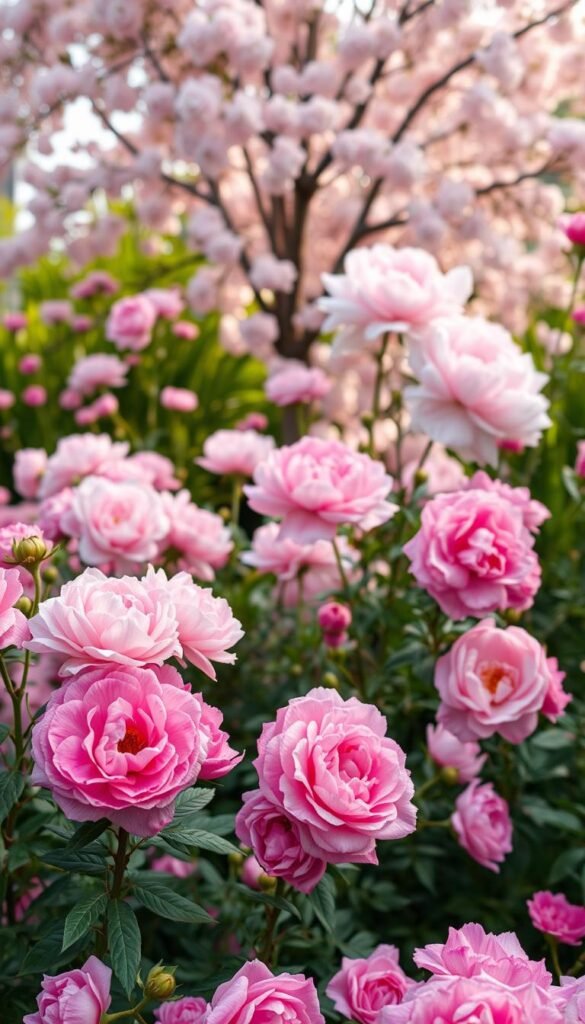
Your floral journey begins with understanding nature’s paintbox. The spectrum ranges from whisper-soft carnation pinks to vibrant fuchsias that command attention. By mixing textures and timing blooms strategically, you craft living art that evolves daily.
Understanding Bloom Types and Colors
Start with bloom timing. Early risers like bleeding hearts pair beautifully with late-summer pink flowers such as cosmos. This staggered approach ensures color from April frosts to October’s first chill. For shaded areas, consider low-maintenance options like astilbe that thrive with minimal care.
Diversity matters. Combine spiky lupines with round peony blossoms for contrast. A study by the University of Vermont found gardens with three+ flower shapes increase visual interest by 40%. Try these combinations:
| Bloom Type | Example | Color Range |
|---|---|---|
| Trumpet | Petunia | Pastel to hot pink |
| Double | Rose | Dusty rose |
| Spike | Snapdragon | Bubblegum |
Balance is key. Use bold magenta zinnias as focal points, then soften edges with blush-colored alyssum. For tricky spots, opt for adaptable shades like coral bells – their foliage adds color even when not blooming.
Remember, your space tells a story. Let deeper hues anchor beds while lighter tones create airy accents. With thoughtful selection, every corner becomes a chapter in your garden’s year-round narrative.
Seasonal Blooms: Planning Throughout the Year
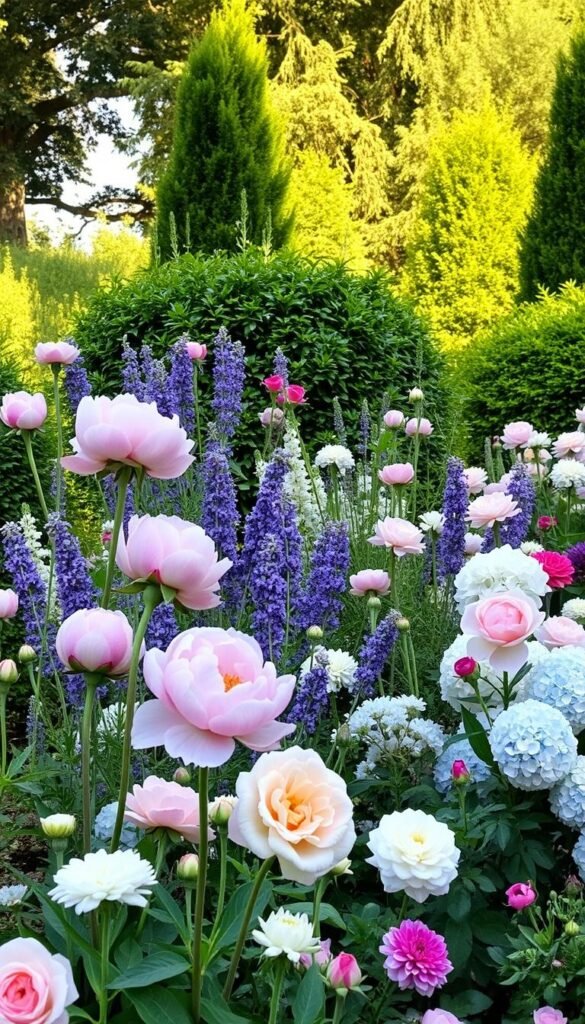
Crafting a year-round floral display requires smart timing and plant choices. By selecting varieties with staggered bloom periods, you ensure constant color shifts that keep your space vibrant through changing weather.
Spring’s Fresh Start with Blush Tulips and Peonies
Early risers like ‘Pink Perennial’ tulips kickstart the growing season in zones 3-7. These cup-shaped flowers thrive in full sun and well-drained soil, offering weeks of rosy charm. Pair them with peonies for dramatic contrast – their lush, ruffled petals create focal points that smell divine.
| Season | Flower | Bloom Time | Zones |
|---|---|---|---|
| Spring | Tulips | March-May | 3-7 |
| Spring | Peonies | May-June | 3-8 |
| Summer | Coneflower | June-August | 4-9 |
| Fall | Sedum | September-October | 3-9 |
Summer, Fall, and Winter Considerations
When spring blooms fade, heat-loving coneflowers take center stage. These drought-resistant plants maintain color through scorching days. For autumn interest, try ‘Autumn Joy’ sedum – its pink clusters deepen to rust as temperatures drop.
Winter planning involves evergreen camellias in warmer zones and bulb preparation for colder regions. “Layer bulbs at different depths for staggered spring emergence,” suggests horticulturist Lisa Mason. This technique works well with beginner-friendly options like crocuses and daffodils.
Arranging Pink Blooms for Maximum Impact
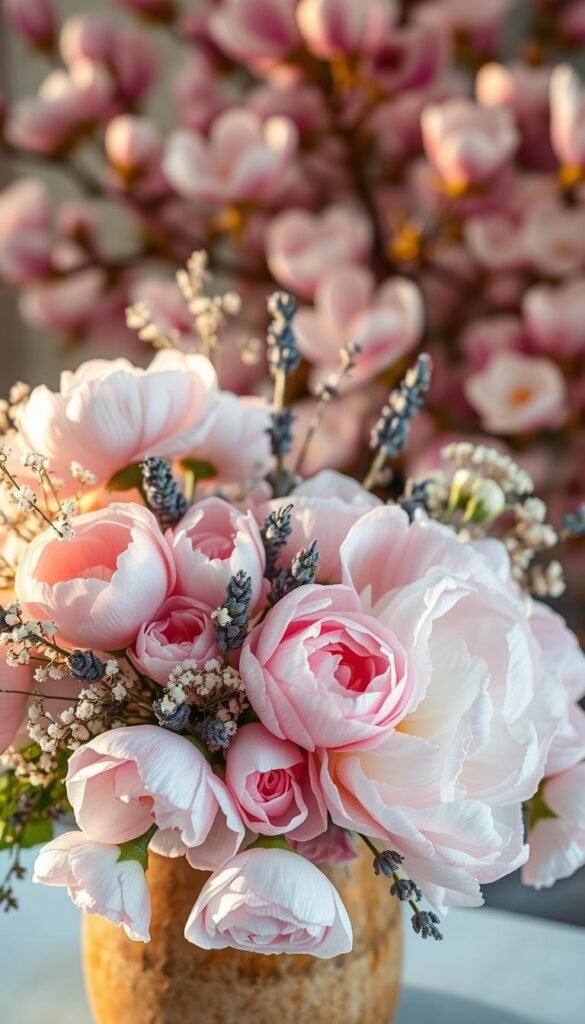
Transform your outdoor space into a living canvas through thoughtful composition. Strategic layering creates depth – pair tall foxgloves with medium-height phlox and creeping thyme. This approach ensures every glance reveals new details while maintaining harmony.
Texture Meets Tone
Mix feathery astilbe with bold hydrangea clusters for contrast. Studies show varied textures increase visual engagement by 30%. Try these combinations:
| Height | Plant | Texture |
|---|---|---|
| Tall | Hollyhocks | Velvety |
| Medium | Dianthus | Fringed |
| Low | Sedum | Succulent |
For flower arrangements, cut stems at 45° angles using clean shears. Change water daily to extend vase life up to 10 days. Blend short-lived peonies with hardy zinnias in bouquets for lasting displays.
Containers offer flexible color placement. Use trailing lobelia in hanging baskets to soften edges. For cottagecore-inspired designs, mix old-fashioned roses with fragrant herbs in terracotta pots.
Remember: transition from pale carnations to deep dahlias in borders. This color graduation mimics nature’s rhythm, creating professional-looking beds that evolve with the light.
Essential Garden Conditions: Soil, Sun, and Water
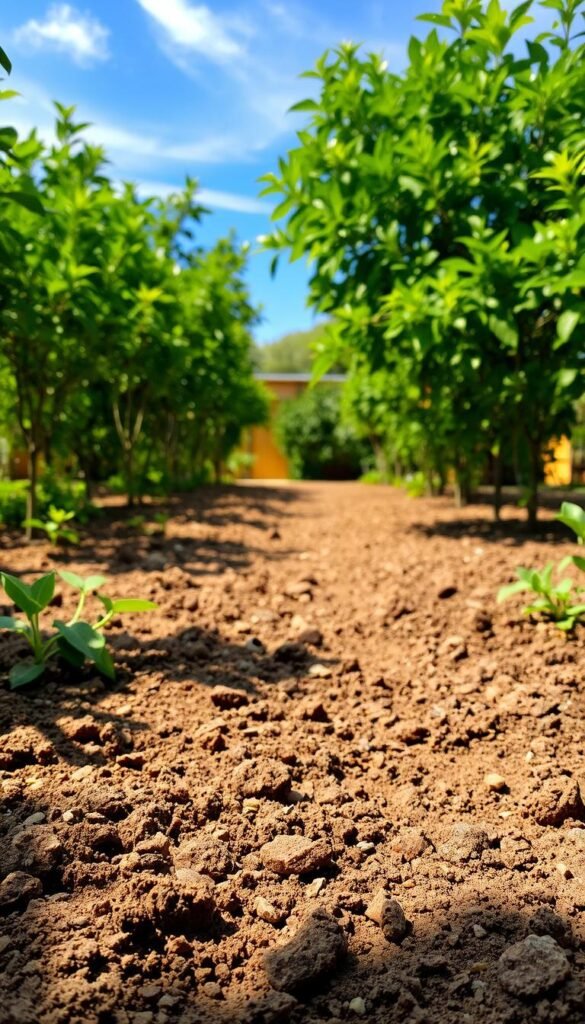
Your garden’s success starts below the surface and above ground. Healthy growth depends on three key factors: balanced earth, proper light, and consistent hydration. Let’s break down how to create ideal environments for your plants.
Assessing Your Soil and Light Needs
Begin with a soil test kit (available at most nurseries). It reveals pH levels and nutrient gaps. Acidic soils (below 6.0) suit hydrangeas, while alkaline earth (above 7.5) benefits peonies. Sandy soils drain quickly but need frequent watering, while clay retains moisture longer.
Track sunlight patterns for a week. Most flowering plants require 6+ hours of direct sun. Shade lovers like astilbe thrive with just 2-3 hours of filtered light. Use this simple guide:
| Soil Type | Ideal Flowers | Care Tips |
|---|---|---|
| Clay | Roses | Add compost yearly |
| Sandy | Zinnias | Water every 2 days |
| Loamy | Peonies | Mulch in spring |
Watch for nitrogen overload – it creates lush leaves but fewer blooms. If your soil test shows high nitrogen, add phosphorus-rich bone meal. For poor drainage, mix in perlite or coarse sand.
Match plants to your natural conditions instead of forcing unsuitable varieties. Water deeply but less often to encourage strong roots. Morning watering reduces evaporation and prevents fungal issues.
Low-Maintenance Pink Flowers That Impress
Who says stunning gardens demand constant attention? Meet resilient varieties that thrive with minimal fuss while delivering showstopping color. Coneflowers lead the charge – these native warriors flourish in zones 3-9, unfazed by poor soil or summer heat. Their daisy-like blooms attract butterflies for months, needing just full sun and occasional watering once established.
Cosmos bring carefree charm to any space. These airy annuals explode with color in well-drained earth, their slender stems dancing in breezes. Plant them where they’ll bask in six hours of daily light, and watch them resist drought while feeding pollinators. Their fern-like foliage adds texture even before flowers appear.
Forget high-maintenance divas. These selections prove you can have vibrant flowers without endless work. Pair them with gravel pathways or rustic décor for a relaxed yet polished look. With smart placement and basic care, your outdoor oasis stays picture-perfect all season long.

